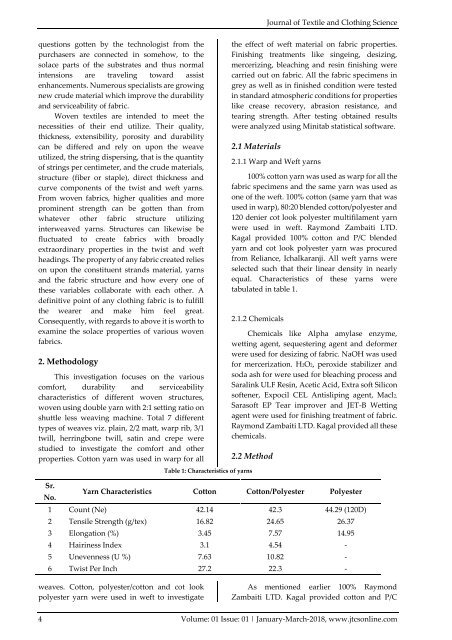JTCS Volume 1 Issue 1
The Journal of Textile and Clothing Science (JTCS) is a peer-reviewed (refereed) journal. Which is aimed at providing the platform to exchange information pertaining to all sectors of textile and the clothing industry among researchers, textile technocrats, fashion designers and industry experts. The journal focuses on scientific, technical, economical, managerial and all other aspects of textile activity at theoretical and experimental level. JTCS is aimed at publishing original research articles, review papers, short communications, and letters to the editor and book reviews catering the needs of both industry and academia.
The Journal of Textile and Clothing Science (JTCS) is a peer-reviewed (refereed) journal. Which is aimed at providing the platform to exchange information pertaining to all sectors of textile and the clothing industry among researchers, textile technocrats, fashion designers and industry experts.
The journal focuses on scientific, technical, economical, managerial and all other aspects of textile activity at theoretical and experimental level. JTCS is aimed at publishing original research articles, review papers, short communications, and letters to the editor and book reviews catering the needs of both industry and academia.
Create successful ePaper yourself
Turn your PDF publications into a flip-book with our unique Google optimized e-Paper software.
Journal of Textile and Clothing Science<br />
questions gotten by the technologist from the<br />
purchasers are connected in somehow, to the<br />
solace parts of the substrates and thus normal<br />
intensions are traveling toward assist<br />
enhancements. Numerous specialists are growing<br />
new crude material which improve the durability<br />
and serviceability of fabric.<br />
Woven textiles are intended to meet the<br />
necessities of their end utilize. Their quality,<br />
thickness, extensibility, porosity and durability<br />
can be differed and rely on upon the weave<br />
utilized, the string dispersing, that is the quantity<br />
of strings per centimeter, and the crude materials,<br />
structure (fiber or staple), direct thickness and<br />
curve components of the twist and weft yarns.<br />
From woven fabrics, higher qualities and more<br />
prominent strength can be gotten than from<br />
whatever other fabric structure utilizing<br />
interweaved yarns. Structures can likewise be<br />
fluctuated to create fabrics with broadly<br />
extraordinary properties in the twist and weft<br />
headings. The property of any fabric created relies<br />
on upon the constituent strands material, yarns<br />
and the fabric structure and how every one of<br />
these variables collaborate with each other. A<br />
definitive point of any clothing fabric is to fulfill<br />
the wearer and make him feel great.<br />
Consequently, with regards to above it is worth to<br />
examine the solace properties of various woven<br />
fabrics.<br />
2. Methodology<br />
This investigation focuses on the various<br />
comfort, durability and serviceability<br />
characteristics of different woven structures,<br />
woven using double yarn with 2:1 setting ratio on<br />
shuttle less weaving machine. Total 7 different<br />
types of weaves viz. plain, 2/2 matt, warp rib, 3/1<br />
twill, herringbone twill, satin and crepe were<br />
studied to investigate the comfort and other<br />
properties. Cotton yarn was used in warp for all<br />
Sr.<br />
No.<br />
the effect of weft material on fabric properties.<br />
Finishing treatments like singeing, desizing,<br />
mercerizing, bleaching and resin finishing were<br />
carried out on fabric. All the fabric specimens in<br />
grey as well as in finished condition were tested<br />
in standard atmospheric conditions for properties<br />
like crease recovery, abrasion resistance, and<br />
tearing strength. After testing obtained results<br />
were analyzed using Minitab statistical software.<br />
2.1 Materials<br />
2.1.1 Warp and Weft yarns<br />
100% cotton yarn was used as warp for all the<br />
fabric specimens and the same yarn was used as<br />
one of the weft. 100% cotton (same yarn that was<br />
used in warp), 80:20 blended cotton/polyester and<br />
120 denier cot look polyester multifilament yarn<br />
were used in weft. Raymond Zambaiti LTD.<br />
Kagal provided 100% cotton and P/C blended<br />
yarn and cot look polyester yarn was procured<br />
from Reliance, Ichalkaranji. All weft yarns were<br />
selected such that their linear density in nearly<br />
equal. Characteristics of these yarns were<br />
tabulated in table 1.<br />
2.1.2 Chemicals<br />
Chemicals like Alpha amylase enzyme,<br />
wetting agent, sequestering agent and deformer<br />
were used for desizing of fabric. NaOH was used<br />
for mercerization. H2O2, peroxide stabilizer and<br />
soda ash for were used for bleaching process and<br />
Saralink ULF Resin, Acetic Acid, Extra soft Silicon<br />
softener, Expocil CEL Antisliping agent, Macl2,<br />
Sarasoft EP Tear improver and JET-B Wetting<br />
agent were used for finishing treatment of fabric.<br />
Raymond Zambaiti LTD. Kagal provided all these<br />
chemicals.<br />
2.2 Method<br />
Table 1: Characteristics of yarns<br />
Yarn Characteristics Cotton Cotton/Polyester Polyester<br />
1 Count (Ne) 42.14 42.3 44.29 (120D)<br />
2 Tensile Strength (g/tex) 16.82 24.65 26.37<br />
3 Elongation (%) 3.45 7.57 14.95<br />
4 Hairiness Index 3.1 4.54 -<br />
5 Unevenness (U %) 7.63 10.82 -<br />
6 Twist Per Inch 27.2 22.3 -<br />
weaves. Cotton, polyester/cotton and cot look<br />
polyester yarn were used in weft to investigate<br />
As mentioned earlier 100% Raymond<br />
Zambaiti LTD. Kagal provided cotton and P/C<br />
4 <strong>Volume</strong>: 01 <strong>Issue</strong>: 01 | January-March-2018, www.jtcsonline.com



